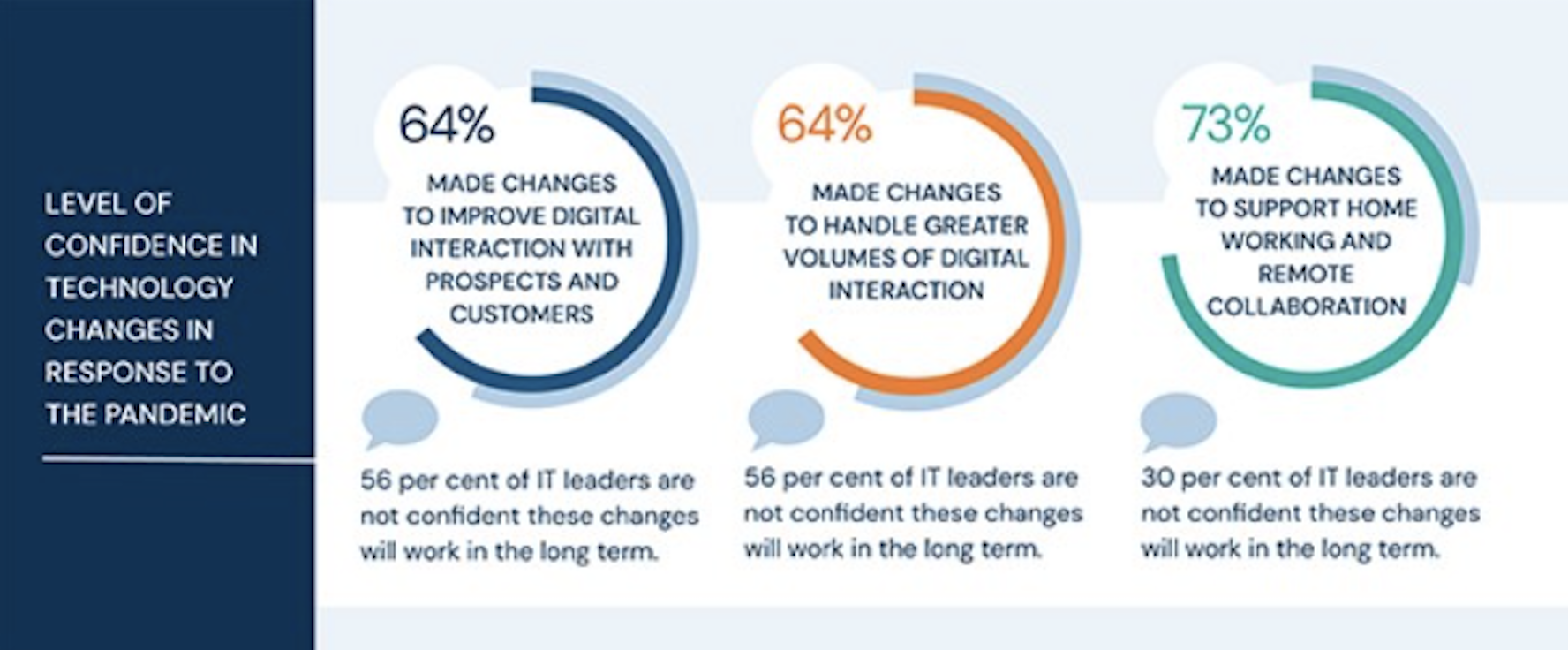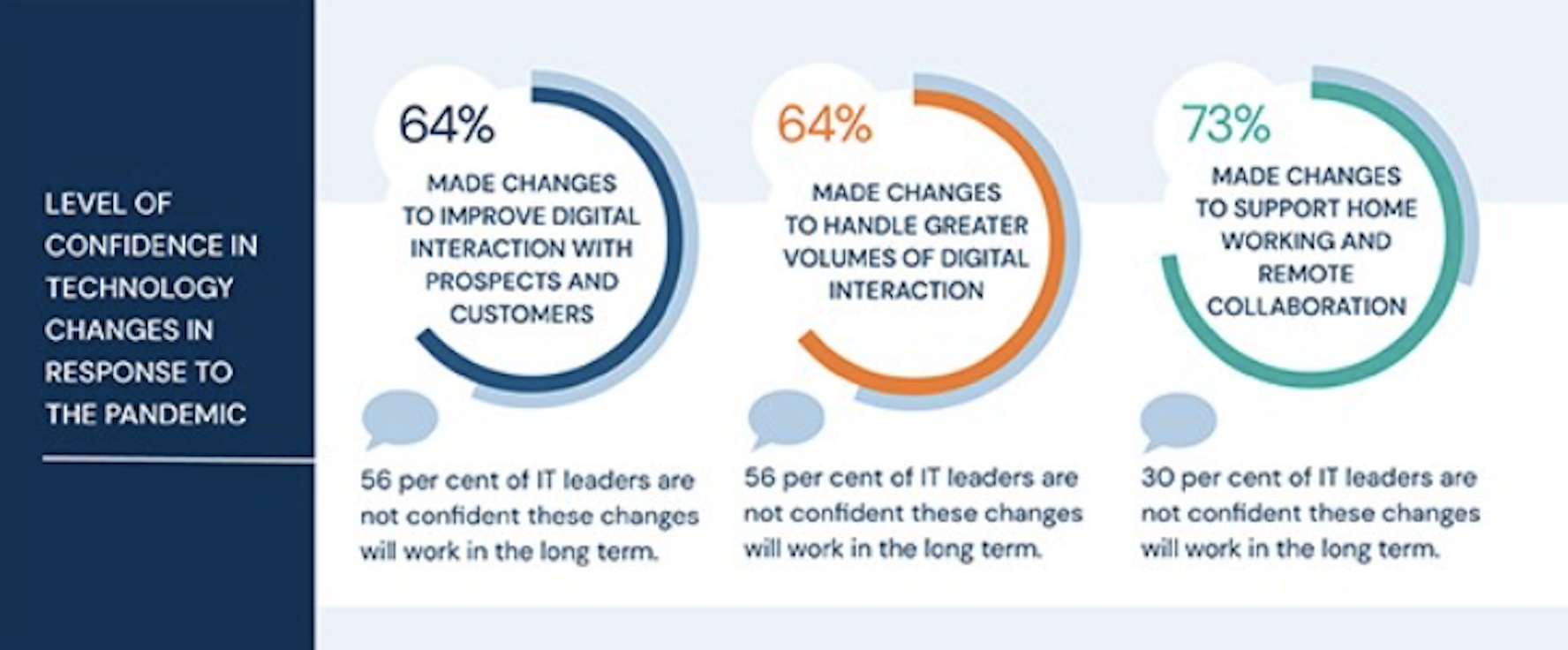 Nearly two thirds of UK enterprises have invested in improving digital customer communications during the pandemic, but over half believe their short-term fixes will not be fit for the long term, a new study revealed.
Nearly two thirds of UK enterprises have invested in improving digital customer communications during the pandemic, but over half believe their short-term fixes will not be fit for the long term, a new study revealed.
With most people locked down and relying on digital communications during the pandemic, around two thirds (64%) of UK IT leaders questioned in a new survey revealed that their organisation made technology changes to improve digital interaction with customers. The same number of respondents (64%) have made changes to handle greater volumes of interaction on their websites, social media and other digital channels. However, in each case more than half (56%), expect to make additional investments to ensure those changes work in the long term.
The survey of 100 enterprise IT leaders, commissioned by Macro 4, a division of UNICOM Global, suggests the pandemic accelerated many organisations’ plans to improve their customer communications technology, but IT chiefs recognise that more work is needed. Almost all of the sample (94%) believe that their organisation needs to improve how it communicates with customers. And nine out of ten (91%) view technology as instrumental in achieving this.
“The pandemic has added new momentum to the shift away from in-person communication,” said Lynda Kershaw, Marketing Manager at Macro 4. “With many face-to-face settings closed and longer wait times in call centres, millions more customers have turned to websites and other digital channels, and businesses have had to scale up their digital offerings to meet that extra demand. At the same time, IT departments are introducing new digital services and channels to make it easier to engage with customers online.”
According to Macro 4, the need for rapid solutions to business challenges created by the pandemic has led to technical compromises which IT leaders will have to revisit:
“CIOs with limited time and resources haven’t had the luxury of planning and implementing the most complete or perfect solution on day one. Now they are seeking to minimize pandemic-induced ‘technical debt’ – the cost of reworking those quick fixes to their customer communications stack so that they work for the longer term,” explained Kershaw.
Underlying these points, 81% of IT leaders in the sample agree (52% strongly) that the need to react quickly to the pandemic has forced organisations to fast-track technology changes to adapt to new ways of working. 72% strongly or somewhat agree that over the next 12 months organisations will have to invest in upgrading or replacing some of the technology they had to implement quickly in response to the pandemic.
“Enterprises will want to reduce waste and effort by building on the short-term solutions they put in during the crisis, rather than starting again from scratch,” said Kershaw. “They will be looking for adaptable, scalable technology, especially in rapidly evolving areas such as digital customer engagement, where innovation can give you a vital competitive advantage. Management techniques such as digital process orchestration can help here by allowing businesses to quickly integrate new technology with existing systems and channels.”
When IT bosses were asked how they felt technology could be used to drive improvements in inbound and outbound customer communications they highlighted a variety of requirements within their own organisations. On average, each respondent selected three different areas for improvement, with no single area dominating overall.
Adding extra security measures to protect us and our customers when interacting digitally (46%) was the most frequently selected area for improvement, closely followed by increasing capacity to manage more digital interactions through digital channels (45%) and adding more digital channels so that we can reach our customers more easily (43%).
The IT leaders in the sample also see a role for technology in improving customer and user experience, with four in ten anticipating benefits from increasing personalisation to meet the needs of different customers (41%) and increasing automation and AI (39%). Bringing customer communications across different departments, systems and channels under one umbrella (40%) can also help to support a more joined-up and holistic experience for customers.
Notably, almost three years after the GDPR came into effect, around a third of IT leaders still feel the need for improving protection of customer data to enable compliance with regulations such as the GDPR, pointing towards a continuing struggle with data protection in many organisations.
To view the full survey results, download Macro 4’s report: Post-pandemic IT: where next?




















